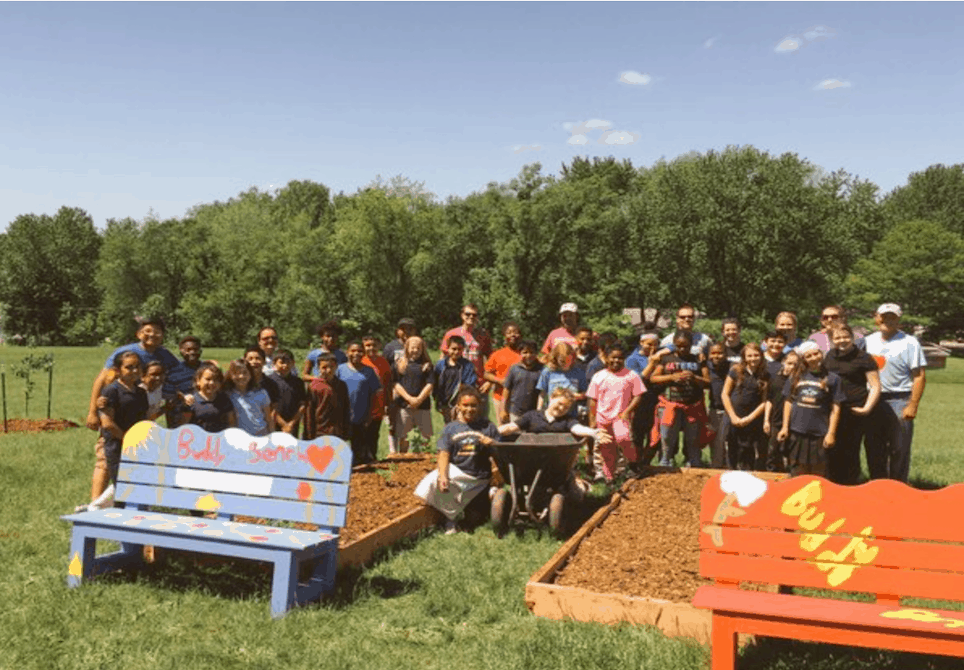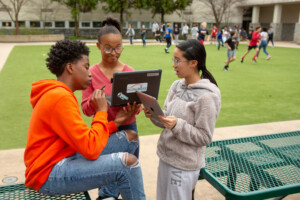From 5 Kids To 25,000 Pounds of Fresh Fruit

By Brandon Gillette
From zero to over 75 in less than 12 months! Sounds pretty slow right? Until you consider what is being measured. In the urban core of Kansas City, Kansas, from 0 to 77 is exactly what happened when one group of students decided in improve their community for the better. As part of a teacher professional development program through a local university, 50 teachers were charged with involving a small group of students from their school in an exhibition of science and engineering. Initially, most groups went to some of the more traditional science fair activities. However, one 6th grade teacher approached her students and decided to ask them what change they might want to see at their school and in their neighborhood. After some poking and prodding and lots of lists, the group of 5 students came up with creating an orchard, though not on the large-scale, profit-bearing nature you might imagine.
At the time, no one involved really knew much about growing fruit, but that didn’t stop the students. The teacher reached out to a local non-profit, The Giving Grove, whose mission is to “improve local food security and strengthen communities by bringing together the resources to develop edible tree gardens.” These gardens (mini-orchards) are seen as a sustainable food production and land management system that provides fresh produce while also offering an educational setting generally not found in an urban setting. Any given site may include just a few trees to more than 100 in total.
Game on! Planting fruit trees with @GivingGrove and @kckschools! #healthyliving #community pic.twitter.com/ZHj2WuViyz
— Brandon Gillette (@DrBGillette) May 10, 2016
Over the next 4 weeks, a number of Giving Grove employees as well as community members came in to work with the students, researching different options for trees, and also planning the orchard site itself. The students learned about different types of trees, different pests and potential problems, and then identified the best possible solutions of trees to plant, and a pest management solution. Situated at 1 of 8 middle school sites in the district, the students designed an orchard that included a dozen fruit trees. Now into the second full growing season, students are learning about plant reproduction, as well as energy and matter flows within organisms and ecosystems to ensure healthy trees and harvests.
This middle school became just the first in the series of six schools in the Kansas City, Kansas Public School district over the next 12 months to research, plan, and plant edible landscapes. The sites are not limited to your traditional fruit varieties either. Orchards across the district include more recognizable apple and pear trees. They also expand into figs, berry bushes, and several varieties of nuts, to the more exotic jujubes and Asian pears.
Checking on the Jujube trees has become a daily routine for the @CEeagles #healthysnacks thank you @GivingGrove ! pic.twitter.com/uO5TOQbAlk
— s_twigg (@ST_elemed12) September 10, 2016
Funding for such projects has come from a variety of sources, including mini-grants from a local university and the Kansas Department of Wildlife and Parks Outdoor Wildlife Learning Site grants. Based on site-specific circumstances, another role of The Giving Grove is to make sure such projects are able to move forward despite funding difficulties.
Of the projects, one student said “I may not be here when the fruit finally starts producing, but my sister will be, and my family lives just down the street. This will be a great resource for us and the neighborhood.” One parent that has helped in the planning process for her children’s school said, “It brings an opportunity to start looking at gardening and teaching kids about healthy foods, our own sort of back-to-nature movement.”
We love celebrating the harvest with our very first community orchard at @HaleCookSchool pic.twitter.com/ULG5nLrUAC
— Giving Grove (@GivingGrove) September 10, 2016
From the six sites, one elementary school, two middle schools, and three high schools, it is estimated that these trees will produce over 25,000 pounds of fresh food annually. And this is just the beginning. In what is generally considered a food desert with respect to healthy alternatives to fast and processed foods, these sites provide a learning opportunity for students, but also access to fresh and healthy produce. For more information on The Giving Grove and to learn how you might include fresh, healthy foods to your school’s students and families, visit www.givinggrove.org.
Visiting The Giving Grove https://t.co/HDe7EWNGuY via @41actionnews
— Giving Grove (@GivingGrove) May 10, 2016
This blog is part of our “Place-Based Education” blog series. To learn more and contribute a guest post for the series, check out the PBE campaign page. Join in the conversation on social media using #PlaceBasedEd. For more on Place-Based Education see:
- Genius Loci: Place-Based Education & Why It Matters
- 20 Schools and Networks That Educate With A Sense of Place
- Place-Based Learning: Wherever You Are, Whenever You Go
Brandon Gillette is a teacher at Pembroke Hill School in Kansas City. You can find him on Twitter @DrBGillette.







PAUL SOPTICK
WHAT A GREAT STORY. GIVING GROVE IS TRANSFORMING SO MANY UNDERUSED PROPERTIES IN TO OASIS FOR COMMUNITY GOOD. GIVING GROVE AND THEIR STAFF FOR HUMANITARIAN AWARD OF THE YEAR.